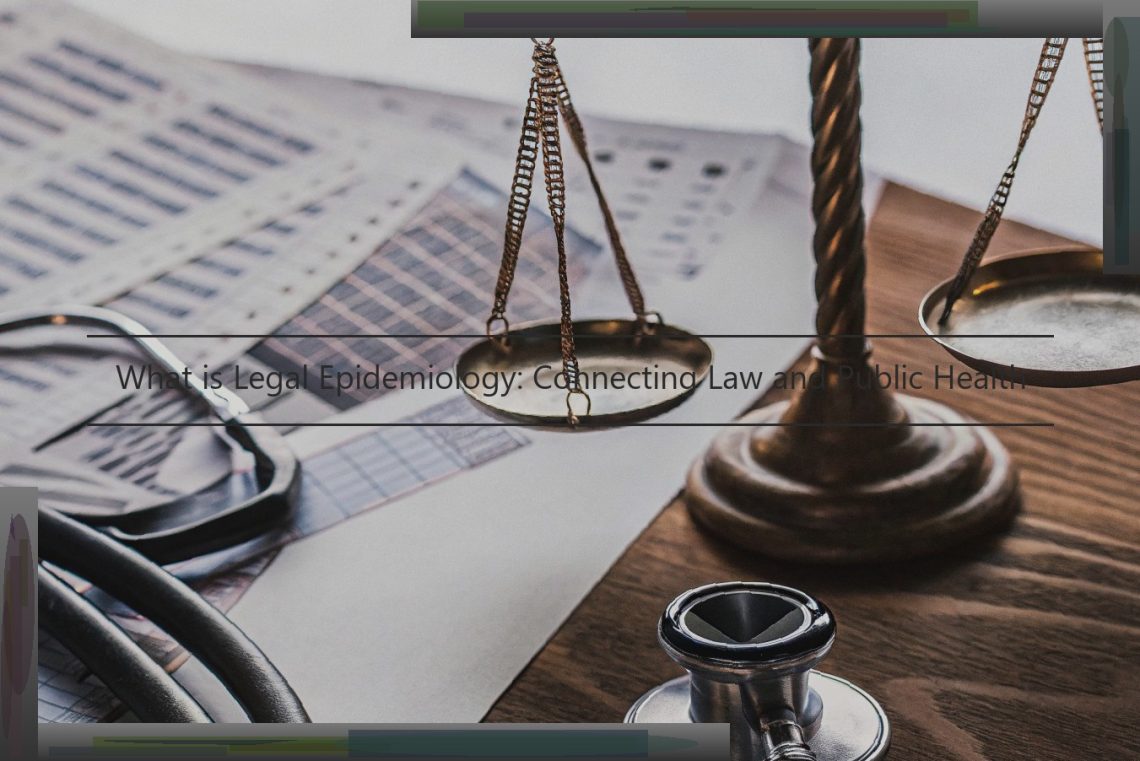
What is Legal Epidemiology: Connecting Law and Public Health
Legal Epidemiology: The Intersection of Law and Public Health
"Legal epidemiology" is defined as "the scientific study of law as a factor in the spread of disease, injuries, and wellbeing." The Center for Public Health Law and Policy at ASU’s Sandra Day O’Connor College of Law writes that legal epidemiology is "a new science at the intersection of law and epidemiology."
Law and regulations govern many facets of society, including, for example, health care administration; health care provider licensing; the regulation of health professions; the conduct of employees in public and private organizations; the distribution, marketing, and sale of products; and criminal and civil law. These laws, rules, orders, and regulations influence how organizations operate. They can also affect how laws and regulations affect population health , particularly the collection and reporting of certain kinds of data, such as health data.
Law has shaped public health efforts, helping to determine where clinics can be built, how tobacco can be advertised, and how hospitals and other medical facilities are built. By recognizing that laws affect population health, efforts can be better targeted to maximize positive public health outcomes and mitigate negative ones.
A growing body of research links evidence-based policy changes to improved public health. Improvements like these may be a factor in why the field is growing. Legal epidemiology can help make sure that the evidence used is a reliable in terms of how law affects health.
Legal Epidemiology’s Contribution to Public Health
Legal epidemiology contributes to public health by studying the relationship between law and the health of a population. Studying the relationship between law and health empowers public health practitioners, researchers and policy makers to better understand the way that social determinants of health interact with the legal system to promote or diminish health outcomes.
The Centers for Disease Control and Prevention defines legal epidemiology as the science of law, legal practices, and health that include "the description, characterization, and evaluation of laws and legal practices, including their impact on public health and health outcomes" (CDC Investigator Brief, 2019). Legal epidemiology can address questions regarding implementation of statutory mandates and evaluate resulting health impacts. For example, legal epidemiology can contribute to prevention of chronic disease by studying the health impacts of state/school policies banning soda sales on school campuses. And legal epidemiology can be used to study the health impacts of laws on food environments, such as rules that encourage farmers’ markets or regulations that require calorie counts on restaurant menus. Legal epidemiology studies may also focus on the health-care system and obligations imposed by statutes and regulations. For example, it may also study the impact of a requirement that states strengthen prescription drug monitoring programs (38 state drug monitoring programs have been evaluated as a legal epidemiology case study).
Approaches Within Legal Epidemiology
Legal epidemiology employs a range of methodologies, from more traditional quantitative strategies to newer qualitative ones. In a quantitative study, researchers might gather prevalence or incidence data on a specific health outcome (such as obesity, cancer, or motor vehicle-related injury) or confounding factor (like tobacco use, littering, or participation in risky behaviors) to assess the potential relationship between that outcome or factor and the law. While at first glance it may seem that this approach does not involve much legal analysis, it is essential to consider the substantive law regulating the behavior to determine whether it is susceptible to the law at hand. For example, if a researcher wished to study the effect of seatbelt laws on car accidentes, he or she would first need to consider whether states have mandatory seatbelt laws and whether those laws are relevant to the behavior. The researcher would then devise a methodology to determine whether changes in the state laws were associated with changes in the prevalence of car accidente or severity of car injuries in the various states.
On the other hand, a qualitative analysis could focus on whether there are gaps or weaknesses in a given body of law as it relates to a particular health outcome or factor. For example, a researcher studying the relationship between the law and obesity and examining zoning codes for food establishments might qualitatively compare two communities that differ in their prevalence of obesity, with one community having more extensive zoning restrictions on fast food establishments compared to another. In analyzing the differences in the obesity rates, the researcher could draw conclusions about the associations between law and health outcomes without having set out to prove causation.
Legal Epidemiology Case Studies
Researchers, including those in the field of legal epidemiology, have long recognized that the law strongly influences health outcomes. As yet however, there has been little research into how best to evaluate and apply the law to improve health. To start answering this need, a working group of lawyers, public health practitioners and scholars from across disciplines has begun to explore ways to analyze and describe associations between laws, policies and health outcomes. An early example of such an effort is the research conducted by Dr. Matthew Miller of researchers including Angela Campbell of Georgetown University, and Keith Paul of the CDC. Their work examines how anti-tobacco laws influence smoking behavior and birth outcomes. Another example is the Tobacco Analysis Index (TAI), a research project being carried out by Professor Thomas Land and Andrew Stenger of the University of Maryland. The TAI analyzes existing tobacco laws and rankings to assess their impact on public health in the state of Maryland. The application of legal epidemiology to studies of the impact of public health laws on community health is also gaining traction in the United States. For instance, state health departments are increasingly using online legal data, such as publication databases of health laws and statutes, to make more relevant data available to public health professionals. A recent study by the New York City Department of Health and Mental Hygiene in collaboration with Columbia University, Paul and Sydney Quest University, and the University of Sheffield concluded that a range of laws in combination affect health outcomes. In this study public health leaders examined a wide range of laws influencing tobacco consumption, fast-food access, sugary beverage restrictions, and more. Drawing from the growing body of research exploring the impact of public health laws and wellness ordinances on health, this new field of research has enabled public health departments to become more active on legislative issues, and has sparked an increase in politics in public health. Finally, a surge in private legal epidemiologists has also resulted in a number of graduate programs establishing both dual-degree (e.g. JD/MPH) and interdisciplinary initiatives on law and public health.
Legal Epidemiology Challenges and Limitations
Challenges and Limitations for Legal Epidemiologists
The legal epidemiology toolbox continues to expand and some methodological issues are surfacing. Data challenges seem to be the most vexing, particularly because they are difficult in the moment of collecting the data. How do legal epidemiologists collect laws when they are the only people legally allowed to do so? Because there are so many actors that can influence the changes made to legal data, legal epidemiologists need a comprehensive coding scheme and workflow. In addition, legal epidemiologists need to understand the context of law and government before they can begin to collect and study it. As such, they have to determine which level of government influences a legal specification within a particular law. Legal epidemiologists must also consider whether they will establish their coding scheme at the level of a single law, or at the level of a single law plus one policy question (if the law in question meets a specific criterion). The complexity of the law inevitably affects legal epidemiology metrics . Another core challenge within legal epidemiology is that, in policy evaluation, the exogenous events might not be independently distributed throughout time, making control and treatment groups difficult to manage. Yet another, more fundamental, challenge for legal epidemiologists is that the legal architecture is often overly complicated, making it difficult to get a sense of the landscape. Legal architecture may vary such that the "same" law can be composed of multiple laws, or that an aspect of a law can be the same as another aspect of another law. Further, there might not even be a law in question—there might be a regulation, guidance, advisory, or administrative code. Commonly, legal epidemiologists grapple with issues on whether or not regulations should be included in their data set, and if so, how they should be coded. In sum, legal epidemiology should not be simplified down to a simple set of rules. It is not as easy as talking about a coding scheme or collecting articles in a systematic review—it is just as much a systematic review of the law and an understanding of its different "levels" as it is a coding scheme.
Legal Epidemiology Future Trends
The future of legal epidemiology hinges on increased collaboration between academics and practitioners, the growing demand for evidence-based policymaking and public health analysis, and the advent of artificial intelligence (AI). Such a mixture will continue to produce public policies embedded with evidence yielded through law and policy analysis. As the trend of "big data" persists, large volumes of unstructured data will generate a need for more formal methodologies and tools that allow practitioners in law and public health to develop appropriate statistical models. This will occur because the use of big data – especially when paired with AI – will yield information that is almost unknowable by humans. AI will pave a wider path for how evidence-based policymaking and public health study develops. Legal epidemiology, with its focus on mapping law and policy to outcomes, will be an important aspect of this trajectory.
Conclusion and Relevance
Legal epidemiology – using the tools of legal analysis to identify and assess law and legal authorities that affect population health – is critical for improving how health policies, laws, and regulations consider a wide range of determinants of health: from environmental exposures to housing, transportation, food and nutrition, occupational safety, health care access, and lifestyles. The interdisciplinary nature of law and health impact assessment research is essential for developing more effective legal and policy solutions to contemporary public health problems.
Legal epidemiology provides important insights into the need for changes to statutes, regulations, state constitutions, or judicial doctrine to address changes in scientific knowledge associated with health risks and disparities, legal interpretations of statutes based on evolving scientific knowledge, litigation across state court jurisdictions, or variations among state and local laws and regulations that impact health . Legal epidemiology can help close knowledge gaps with evidence about how laws and legal authorities currently operate in response to evolving public and environmental health challenges, where legal barriers and opportunities exist. More fundamentally, legal epidemiology can be used to study how policy options align with and further existing legislative intent, as expressed in statutes, regulations, and other legal authorities. By doing so, law and health impact assessments can guide the development of laws and regulations that better reflect what communities and populations really need to positively impact their health.




